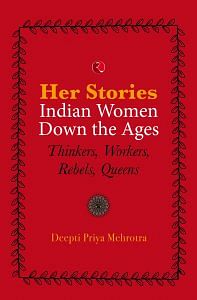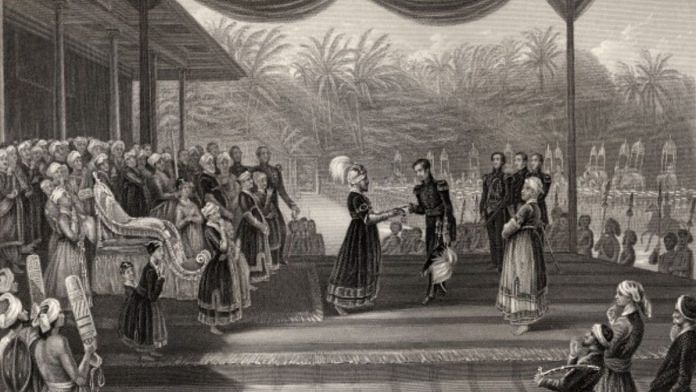Nangeli rebelled against an exploitative regime, in Travancore state, which charged exorbitant taxes from the common people: in particular a tax called Mulakkaram, which was levied on all Dalit women, in particular those who wore clothing covering their breasts. Nangeli was Dalit, from the Ezhava community. She spoke up not only for herself but for all labouring Dalit women. Her protest helped light the spark of rebellion in her area.
Nangeli and her husband Chirukandan lived in Cherthala, a small coastal village. They worked as agricultural labourers and collected sap from coconut trees. Travancore Rajas ruthlessly extracted some 110 kinds of levies from Dalit people—on the fisherman’s net, ornaments worn, a moustache sported and so on. A general tax was levied on men called Talakkaram, literally ‘head tax’; Mulakkaram literally means ‘breast tax’.
Anyone of Ezhava or Nadar caste was expected to appear bare-torso in the presence of Brahmins, royalty or generally anyone of higher caste. Traditionally, it was common for men and women of various castes to be bare-chested—and no shame attached to women’s bare chest. By the late eighteenth century however, clothing, especially women’s upper-cloth or blouse, took on pronounced symbolic significance as a marker of social identity.
Among women, chest-covering was permitted only to those from high castes. Mulakkaram began to be collected from all Ezhava women—beginning from puberty onward. The parvarthiyar, a local official, would collect Mulakkaram, going from door to door in Dalit neighbourhoods.
Also Read: You can’t exclude Dalits when talking feminism. See what bell hooks did for Black women
Anger was brewing against the unjust tax. Nangeli felt keenly the injustice her community was subjected to. The burden of taxes left them with hardly a handful of rice to eat at day end. They worked to the bone, yet there was always some tax to be paid; a blanket of fear covered them, and so life carried on.
Nangeli knew the parvarthiyar would soon arrive to collect Mulakkaram. Born of intense anger, her resolve was building up over the years. She decided she would not pay Mulakkaram that day, or ever again. She could not win against state brutality by any of the usual tactics. Nangeli thought of something unprecedented, a dramatic act that would draw attention to the tyranny being enacted in Travancore.
When the parvarthiyar and his men came to collect Mulakkaram, Nangeli asked them to wait. They waited, relieved that she was quiescent, and would soon bring them the tax in the usual form, that is, rice. They were accustomed to collecting taxes thus: rice placed on banana leaves.
Nangeli indeed had two long green banana leaves ready. She had sharpened her sickle too. All her life she had worked in the fields, and was adept at handling the sickle. She now picked up the tool, and in one smooth motion, slashed off one of her own breasts. The searing pain was unbearable; the wound bled on her body like a fountain. She carried on like one possessed—another deadly stroke. Placing both breasts on the banana leaves, hardly any strength left in her mutilated body, she went out to the waiting officials. Nangeli offered them her two breasts, mangled flesh that had, a minute ago, formed an integral part of her beautiful body.
Also Read: Kausalya Baisantri, an early Dalit woman autobiographer, fought a ‘double curse’
Before she bled to death, Nangeli saw, to her great satisfaction, the stricken look on the faces of the parvarthiyar and his men, horror and panic writ large, as well as urgent recognition. She knew in that moment that her sacrifice was not in vain. The state official recognized her sacrifice, and wordlessly acknowledged the wrong done to Nangeli and all Dalits. Nangeli the fighter, passed away knowing that word of her brave deed would spread like wildfire. It would make a difference.
As Nangeli collapsed in a heap, the parvarthiyar fled, leaving the severed breasts lying next to her corpse. Neighbours gathered, and someone ran screaming to fetch Chirukandan. Grief-stricken, he joined his beloved wife. In protest against the unjust regime, the story goes that he jumped into her funeral pyre, and burned to death.
Nangeli’s protest sent shock waves throughout the state. The next day, Sreemolam Thirunal, king of Travancore, issued a proclamation revoking Mulakkaram, fearing an agitation. The area she lived in came to be known as Mulachiparambu (land of the breasted woman). However, Dalit women were still prohibited from wearing top clothing when in the presence of upper castes.
Maaru Marakkal Samaram, or Channar Lahala (revolt) of Dalit women burgeoned in the state a decade later—a collective revolt of Dalit women fighting for the right to wear upper-body garments. Nadar and Ezhava women campaigned to be allowed to cover their breasts. The British passed an order permitting Christian women to wear upper cloth in Travancore, but withdrew it after the Raja’s council objected that this would obliterate caste differences. Nadar women were forbidden to wear upper-body cloth, but could wear a short jacket called kuppayam. Ezhava and Nadar women continued the struggle, and were violently opposed by upper castes. Travancore royalty issued a proclamation in 1829, denying Nadar women the right to wear upper cloths.
Also Read: Dalit cook Sunita Devi resisted in Uttarakhand. And became a potential Rosa Parks for India
As the agitation raged, in 1859, the Travancore Raja granted Nadar women the right to tie cloth around their upper body, but only in a specific way.
By the late nineteenth century, Dalit women’s struggles on the issue succeeded in Travancore. In Cochin and Malabar, where similar practices prevailed, struggles carried on well into the twentieth century.
Nangeli’s protest is hardly mentioned in official history; even in Cherthala, most people have forgotten her. Her humble hut has long vanished; no memorial was built to commemorate her. Local leaders like C. Kesavan and K.R. Gowri Amma recall her courage. Her great-great-granddaughter, Leena, retells her story with pride. A new generation draws inspiration from her incredible story, and the contemporary Dalit movement continues the struggle for an end to exploitation, and the establishment of social justice.

This excerpt from ‘Her Stories: Indian Women Down the Ages’ by Deepti Priya Mehrotra has been published with permission from Rupa Publications.



